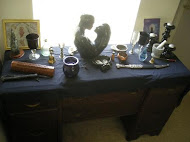This is taken in it's entirety from The Element Encyclopedia of Witchcraft by Judika Illes.
A fairly universal stereotype of the witch portrays her with unruly hair; perhaps a visual declaration that she is a person who will not be ruled. In fact, in Jewish and Slavic folklore, among others, to describe a woman as having "disheveled hair" is the telltale instant giveaway that she is some kind of witch, whether human, demonic or divine.
Hair also figures prominently in the myths of Sedna, Inuit ruler of the seas. Sedna sits on the ocean floor, her chief companion her familiar dog. (Visualize something like and Alaskan malamute.) She controls the balance between the sea creatures, who wish to live, and the people ashore, who wish to live, too, and thus must hunt, catch, and eat those sea creatures. Sedna, like the sea, is volatile and moody: she manifests anger and depression by withholding the ocean's bounty.
When food becomes scarce, the only way to restore balance is to soothe, comfort, and appease Sedna. An intrepid shaman must soul-journey to Sedna's water abode, approach her and calmly, gently, comb out the painful knots and tangles from her long, thick matted hair. Only when this is accomplished will Sedna's anger, frustration, and deadly agitation pass.
Witchcraft, shamanism (more about this soon), magic, conjuring, herbalism, "traditional" spirituality, religion: like Sedna's locks these may all be too deeply entangled to ever completely separate. However, attempts to comb them out will hopefully soothe agitation and frustration, and will definitely reveal secrets and release hidden treasures.
Let's examine the primal roots of witchcraft and the various historical elements that have shaped witchcraft and influenced perceptions of it.
The Roots of Witchcraft: The Magical World
How far back do we have to go to find that primal witch? Well, how far back can we get? Because no matter how far we can go, we will discover magical practices waiting for us.
Recognition fo magic power and the accompanying urge to manipulate it exists from earliest creation. Folklorist and practitioner of magic Zora Neal Hurston identified God as the original hoodoo doctor, because he spoke the world into creation with a series of magical words. That's a concept that would have been familiar to the ancient Egyptians. Among their many creation stories is one where Ptah the craftsman god, the original mason, also brings the world into existence using magic words. Other creation stories from all over Earth posit a similar magical creation. The world and all inhabitants, including people, are created via incantation, song (charm), visualization, spell-casting, or image-magic: figures molded from Earth, life magically breathed into them.
Other creation stories make the magical connection very explicit. In another Egyptian creation tale, the Creator, having contemplated creation, realizes all will not be well and that people are potentially in for a lot of grief, heartache, and trouble. Feeling remorseful, the Creator quickly invents magic power (heka to the ancient Egyptians) for people to use to ward off the harsh blows of fate. Magic is thus a crucial necessity of divine origin.
Another creation myth is both explicit about primordial witchcraft and ambivalent toward it. The Zuni are an indigenous nation of the North American south-west; according to their cosmology, shortly after Earth was populated, a sacred pair, male and female, commonly identified in English translation as "witches," emerge bearing gifts. While traveling around, examining Earth, this pair, these witches, meet some young women and ask them who they are. The girls say they are Corn Maidens but they have a problem: corn doesn't exist yet.
The witches immediately remedy the situation, distributing seven varieties of corn as will as squash and melon seeds, the staple diet of the indigenous farmers of the American south-west. This gift stimulates the Corn Maidens to form a pair of lines facing the sun and begin a dance in tribute: the birth of religion and agriculture, with full approval from the witches. This is a nice witch story. The witches, however, also bear another gift: death. They insist death is necessary to prevent Earth from becoming overcrowded. People, however, are horrified and behold witches, responsible for life-saving sustenance and the introduction of death, with suspicion ever after. It is an early acknowledgement of ambivalence toward witchcraft: the power to heal and preserve may also be wielded to harm and destroy.
You don't hold any stock with mythology and ancient creation tales? That's OK; let's take a look at what the archeologists and anthropologists have to say. Plenty of physical evidence documents the primordial origins of witchcraft and magical perspective.
Physical Evidence of Magical Thought
Much of what we know of Paleolithic (Old Stone Age) cultures derives from excavations of funerary sites. Survivors lovingly cared for their dead compatriots, preparing them, sometimes painstakingly, sometimes at great expense, for whatever was perceived as lying ahead. They cleansed and groomed the bodies, dressed them, ornamented them with flowers, beads, seashells, and amulets. They left grave goods: whatever was needed for pleasure, nourishment, and safety in the next realm as well as for the journey there. Sometimes payment and/or guides for that journey were magically provided too, as well as guardians to protect whatever was understood to be left behind.
"Life" to these ancient people clearly didn't just terminate with death, as if the plug being pulled, everything was over. They had a broader, magical perspective of what constitutes "life" that didn't end with the last heartbeat or breath. Instead one existence passed into another, one read leading from one realm into another. The modern phenomenon known as the one-way street, however, had yet to be invented. Had it been, there would be far less discussion of shamanism today and maybe none of the necromancy. All roads could be accessed from both directions. Mysteries of death and what comes after remain integral to witchcraft.
The mysteries of death were not our ancestors' only concerns, however; neither are they the main focus of witchcraft. Mysteries of birth and life were equally important - the flip side of the coin.
In 1908, a small statuette depicting a round, rotund female was discovered by the archeologist Josef Szombathy near Willendorf, Austria. The most famous of countless similar statuettes she was nicknamed the "Venus of Willendorf" and is now in Vienna's natural history museum.
Her nickname was meant ironically. To modern ears, the name "Venus" epitomizes female beauty and grace, which currently almost inevitably means thin, smooth, firm, and youthful. The Willendorf Venus amused the archeologists who discovered her. Like many other statuettes of her era, she is fat and corpulent, displaying rolls of flesh and large, sagging breasts. She is not a figure of humor, however, nor was she intended to be grotesque. She is very carefully crafted. Her hair is beautifully coiffed in seven concentric rings - seven apparently already recognized as a magical number. She is an object of wonder.
How long ago was the Venus of Willendorf crafted? Whose eyes should we attempt to see her through? As the technology of establishing chronology improves, her age has been revised several times, consistently backwards. She was originally thought to date from 15,000 to 10,000 BCE, but the date now suggested is from 24,000 to 22,000 BCE, quite a few years ago. Today, in this era of super-sized meals and sedentary occupations, the Venus of Willendorf's figure is far from unique. People battle to avoid her shape, resorting to surgery and all sorts of drastic diets. Imagine, however the hard-scrabble existence of some 20,000 years ago. Through the eyes of those days, the Venus of Willendorf must have been regal, queenly, self-contained, divine. She is the image of woman as the source of life, plenty, peace. fertility, and prosperity. Today's ideal woman is squeezed into as little physical space as humanly possible. Not the Venus of Willendorf. She's expansive, comfortable, and takes up as much space as she needs.
The Venus of Willendorf is but the most renowned of countless other ancient surviving images of the sacred female. Not all share her figure; some are slender. Almost uniformly, however, those parts of the human anatomy that are uniquely female (breasts, vulva, pregnant belly) are emphasized and frequently exaggerated. Whoever created these images (and they are literally countless and crafted over millennia) made sure that no one could ignore or overlook the fact that they are resolutely, profoundly, female.
What we can see is that the people who created and venerated these images were not afraid or repulsed by large women, powerful women, or sexual women. Some of these images seem remote. Some may be wearing masks. others lack facial features altogether, yet virtually all have vaginas, accentuated so that you can't miss them. Some cradle their breasts, offering them to viewers the way a nursing mother does with her child. Some point knowingly to genitals and swollen bellies. They are simultaneously maternal and sexual. Maternity and dynamic female sexuality were obviously not mutually exclusive to the eyes that carved and beheld these figures. Many are very beautiful even by modern conventional standards, with loving, mysterious faces. What is very clear is that our ancient ancestors perceived profound power and magic in the female form. In fact, many anthropologists and scholars of religion believe that the oldest cosmologies start with a mother. In other words, the very first god was a mother.
And of course , who is more godlike than a mother? It is difficult to remember in these days of modern conveniences like infant formula, hospitals, and nannies but once upon a time survival, happiness, and health depended entirely upon one's mother. If your mother was powerful. devoted, healthy, and focused on your well being, your future seemed assured. If your mother was vulnerable, unable or unwilling to care for you for any reason, your future was tenuous indeed.
Everyone's individual mother might be their own private goddess, but actual goddesses served as mothers of communities, tribes, and nations. Many of these simultaneously wonderful and terrible goddesses survive, as for instance India's Kali and Russia's Baba Yaga. Kali Mata (Mother Kali) remains an actively venerated Hindu goddess; her vast complexities and contradictions celebrated and wondered upon. By contrast Baba (Grandma) Yaga was banished to the forest and marginalized as a witch.
Loads of wonderful images of the divine female, together with analyses, may be found in Buffie Johnson's Lady of the Beasts (link is to the book, available online) (HarperSanFransisco, 1988), as well as in the many works of archeologist and historian Marija Gimbutas.
The image of the sacred female doesn't stand alone. Among the several dancing figures painted in the cave of Les Trois Fr`eres in Ari`ege, France is one nicknamed the "Dancing Sorcerer." Dating from approximately 10.000 BCE, this two-and-a-half-foot high figure is a composite of many creatures. He possesses the antlers and torso of a stag and a wolf's tail. Interpreters argue as to whether his paws and phallus belong to a bear or a lion. The beard and dancing legs definitely belong to a man and there is something essentially human about the entire dancing figure. Many speculate that what we see depicted is a costumed, masked man.
This horned figure may be a dancing shaman or corcerer, or both. He may be the "Master of the Beasts." He may be the ancestor of one or more of the wide variety of horned male deities: Cernunos, Herne, Faunus, or Pan, or he may be an early depiction of any or all of them. He will emerge from his hidden cave to haunt us durint the With-hunts. (See HORNED ONE.)
Among the most historically revealing archeological excavations is that of the city of Catal Huyuk, located in what is now modern Turkey. The city was rebuilt many times over thousands of years. There are 12 layers on the site; the age of the oldest has not yet been reliably determined but the most recent is from c. 5600 BCE. The entire area was forsaken in approximately 4900 BCE for reasons yet unknown. This was a large city; at its height it's believed to have supported 6,000 people (a huge population at that time), and it contained many shrines and temples. Among unearthed artifacts are those which are immediately recognizable and meaningful to modern witches and/or goddess devotees: bull's horns all over the place, images of birthing women strategically placed near these horns, plus a statue of the a massive, enthroned woman, seated between a pair of lions or leopards (animals which both once inhabited Europe.) The image is recognizable as that of the Mafna Mater, the Mountain Mother, the Great Goddess Kybele, who according to one version of her sacred myth is a deified witch. (See DIVINE WITCH: Baba Yaga; Kybele.)
To be continued....
Disclaimer: No one involved in this blog or its contents may be held responsible for any adverse reactions arising from following any of the instructions/recipes on this blog. It is the reader's personal responsibility to exercise all precautions and use his or her own discretion if following any instructions or advice from this blog.














